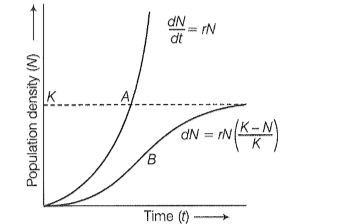Match column I with column II and select the correct option from the codes given below.
Column I
Column II
A. Commensalism
(i) One inhibited other unaffected
B. Parasitism
(ii) One benefited other unaffected
C. Mutualism
(iii) Both are benefitted
D. Amensalism
(iv) One benefitted other harmed
A
B
C
D
1.
(iv)
(ii)
(iii)
(i)
2.
(iii)
(iv)
(ii)
(i)
3.
(ii)
(iv)
(iii)
(i)
4.
(ii)
(iv)
(i)
(iii)
The process where a population inhibits the growth of other population without affecting itself is known as
1. Amensalism
2. Parasitism
3. Mutualism
4. Commensalism
Which of the following is not a factor that would limit the growth of a population?
1. Food shortage
2. Immigration
3. Disease
4. Famine
The graph shows two types of population growth curve. A is exponential and B is logistic.
Which one of the following growth model considered as more realistic one?
1. Exponential growth curve
2. Logistic growth curve
3. Both the growth curves
4. None of the above
In an area, a population with large size individuals having long life span, more parental care and slow development was present. The type of population growth curve will be:
(1) S-shaped
(2) J-shaped
(3) Z-shaped
(4) All of these
The plants which can withstand with narrow and broad range of temperature tolerance respectively are:
1. monothermal and stenothermal
2. stenothermal and monothermal
3. stenothermal and eurythermal
4. stenothermal and mesothermal
Resemblance of one organism with its surroundings for protection and hiding is
1. mimicry
2. predation
3. adaptation
4. camouflage
Sinking of zooplankton during the day and rising to the surface at night is an example of
(1) circinal rhythm
(2) circadian rhythm
(3) tidal rhythm
(4) None of these
| Birth rate = B | Death Rate = D |
| Emigration = E | Immigration = I |
| Column-I | Column-II |
| A. Population is stable | I. B + I > D + E |
| B. Population is increasing | II. B + I = D + E |
| C. Population is decreasing | III. B + I < D + E |
| IV. B + E > D + I |
1. A - II, B - I, C – III
2. A - II, B - IV, C - III
3. A - III, B - IV, C – I
4. A - I, B - II, C - IV
Animals with a constant body temperature such as mammals and birds require more food than do animals with a changing body temperature such as reptiles and fish. Why?
(1) Much of the food is utilised to produce heat to keep warm
(2) Warm-blooded animals waste more food than cold-blooded animals
(3) Cold-blooded animals digest their food more efficiently than warm-blooded animals
(4) None of the above

